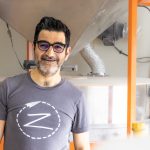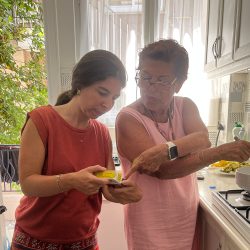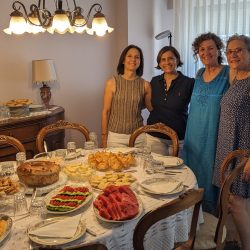When I was growing up in North Cyprus (the Turkish side), we used to frequently take family trips to Turkey. These were summer trips along and up the south-southwestern coast and to Istanbul to visit family friends. My first trip was on the ferry with our car. I loved it. To this day, the sea is my happy place.
The fondest memories, though, were about food. Eating black olives and peksemet (the mastic & clove-spiced Turkish Cypriot gate-shaped bread sticks with sesame, anise, and chernushka seeds) in the car while waiting to get onto the ferry. I’d bite one, then the other, alternating on and on. Then, the foods in Turkey—they were simply delicious; similar to my mom’s cooking (she learned most of her cooking from her host family in Istanbul during her college years). Some were new to me, and often with ingredients that were of higher quality than what I was used to in Cyprus.
We used to visit Ali Bey Amca’s family on the Asian side of Istanbul (Bey Amca meaning “Mister Uncle”, signifying respect to one’s elders). He and his family loved to eat, so I was lucky. Having a meal in their house meant a home-cooked feast. Breakfast was probably my favorite, with its various cheeses, tomatoes and cucumbers, olives, cured meats, bread, borek (a traditional pastry with layers of thin flaky dough typically with a filling of cheese, spinach, or beef), jams, and more. I recall Ali Bey Amca telling us about the food—how this cheese came from this part of Turkey; the olives were cured that way from that region; we used this butter for the borek; and the list went on.
In Istanbul, one has access to the bounty of produce and ingredients the country has to offer. The way Ali Bey Amca hosted us was a prime example of that: he liked the really good stuff and made a point to have them on his table. Besides the flavorfulness of the food, it was the hospitality and the energy of the meals—leisurely sitting altogether at the table, his family and ours—that I cherished. I still do, to this day. Later in life, when he visited us in Cyprus, he’d recall our times visiting them in Istanbul, humoring us in his boisterous voice: “We are all eating at the table, and my eye catches Hazim. He is in a trance, making “ooo” and “aaa” noises, savoring every bit of the food on the table. The kid knows how to eat!” My wife and I were lucky to have him as a wedding witness, and he has since left us. Together with my mom, they left their legacy on my food world.
That kid who savored his food grew up to be an engineer, only to find his way back to the table for a career in great food, here at Zingerman’s Bakehouse. Yes, I am lucky that I was able to follow my heart and my gut! I am also very grateful that one of the myriad learning opportunities here (like the Great Food Group Scholarship) allowed me to revisit and explore that rich tapestry of food, focusing on the Sephardic-Jewish cuisine in Istanbul and Izmir. As Amy mentioned in the first installment of our blog series, these two cities were mainly where the Sephardic Jews of Turkey still thrived and held onto their heritage (there are even smaller pockets of Sephardic Jews in other parts of Turkey, such as Edirne and Canakkale). All in all, it was a great way for me to combine my love of food, my desire to be closer to the culture and cuisine of my own roots, and learn something new about this world that I still feel a part of. Here is how I summarized it in the vision that I wrote while applying for the Great Food Group Scholarship:
“Because of my Turkish Cypriot heritage, I have always been biased towards Turkish baked goods, from “simit” to “peksemet” to “borek”. Even the Hungarian pogásca with its butter and dill has a place in my heart, because my mother had prepared a Turkish version of it with mint and halloumi for us growing up. Wanting to explore the foods of my own heritage and considering how we wanted to focus on Sephardic Jewish foods as part of the ZCoB [Zingerman’s Community of Businesses] 2032 vision, I started thinking and researching about Jewish foods in Turkey. In the world of baked goods, what quickly came up was the laminated street treat of the coastal city of Izmir in Turkey and its Sephardic roots. A bit more reading revealed a whole world of Sephardic culture and cuisine that is present in this city, which I have actually visited once or twice in my life before during family summer trips along the southwestern coast of Turkey. Amy and I thought jumping into an adventure where we explore the Sephardic culture/cuisine of this city could be a great start for the bakery to expand its Jewish food horizon while honoring my own desire to be closer to my roots.”
Amy finished our last blog piece, describing our first cooking workshop adventure with Lian and her Aunt Simone, on Burgazada. As Lian envisioned and we happily obliged, it was a wonderful way to dip our toes into the learnings of Sephardic-Jewish cooking in its Turkish context. A summer house with doors and windows open, letting sunshine and much needed sea breeze in, informal chats down memory lane, inquisitive and hungry minds, a bit of cooking, eating and note taking… Personally, besides the food, I was savoring the experience of ‘working’ on food—intently listening, going back and forth between Turkish and English, and sharing similar versions or stories of Turkish food from my own upbringing, such as the semolina dessert Amy mentioned earlier.
We followed this workshop with a quick visit to the local Synagogue down the street for a bit of history and current context, adding richness to our exploration. After a bit more leisurely strolling through the uneven streets adorned with charming houses and bougainvillea trees, and a few warm greetings with the locals, we arrived at Tamar’s place, where she welcomed us into her beautiful backyard for some homemade cherry liquor and more tasty treats. Tamar Tascioglu, a local Armenian and an experienced ex-hotelier was, similar to Lian and Simone, proud of her heritage. Lian had told us that Tamar’s homemade liquor was something we may want to experience. Her deep red, clear cherry liquor she served to us under the delicately situated canopy of bright pink bougainvillea didn’t disappoint; her passion and skill were apparent. It felt like the perfect afternoon digestif to go along with Tamar’s story of how she used food and gatherings at the table as a meaningful way to preserve and share her heritage. We were content and inspired to learn more!
After a calm seaside dinner and a restful night, we woke up the next morning and hopped on a ferry to visit Büyükada (or Big Island), the largest and the most populated of the Princess Islands. As we walked onto the island, we could immediately feel that it was the most touristy as well, but that did not deter us from our mission. Similar to what we did on Burgazada, Lian had planned another day of cooking at a friend’s house with some bakery visits sprinkled in. On we went to our first destination, along the crowded market main fare, where the winning soccer team’s flags were hanging mid-air, swaying to the ever present seabreeze.
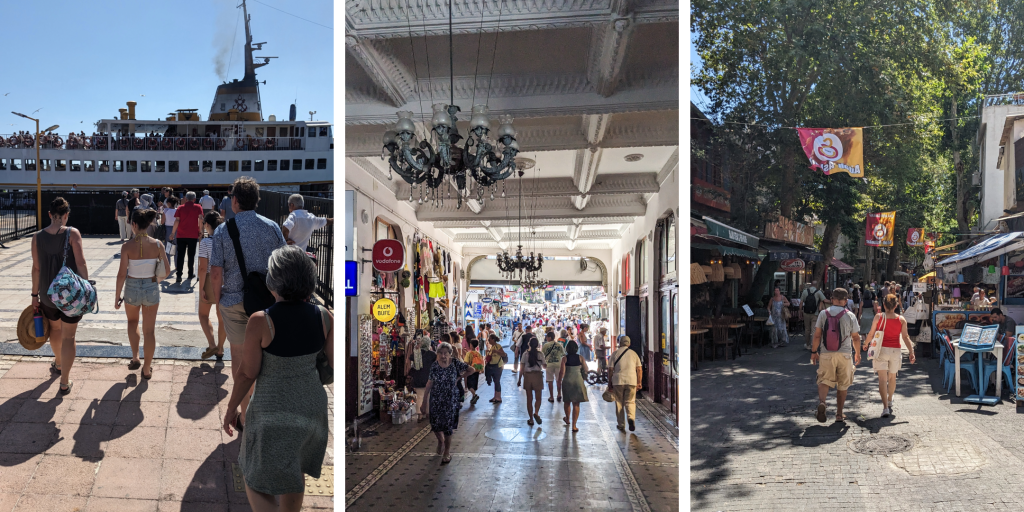
The long line out the front door of Buyukada Pastanesi (“pasta” means pastry, and pastanesi, pastry shop) was a strong sign of the quality and popularity of the baked goods at this decades-old local gem. Luckily, knowing the owner, Lian had called in advance and was able to ‘reserve’ some of the traditional favorites because she knew they would run out before we could get there. I followed Lian, feeling a bit guilty moving ahead of everyone in line, so that she could talk to the owner and ask for our treats.
The variety of pastries on display was almost dizzying, and I learned most, if not all, were baked daily—no easy feat! Snugly sitting around a table outside, we enjoyed a couple of types of borek: a sweet one with pastry cream and a savory one with slightly smoky, fire-roasted eggplant. While I had my share of borek, these ones were new for me, especially the sweet one, which was decadent and light at the same time. The use of eggplant in borek immediately reminded me of my grandmother’s heartier version where she paired the eggplant with ground beef, tomatoes and mildly hot peppers (she’d greet me with this borek at the airport every time I’d come back to visit them in Cyprus while studying in the US).
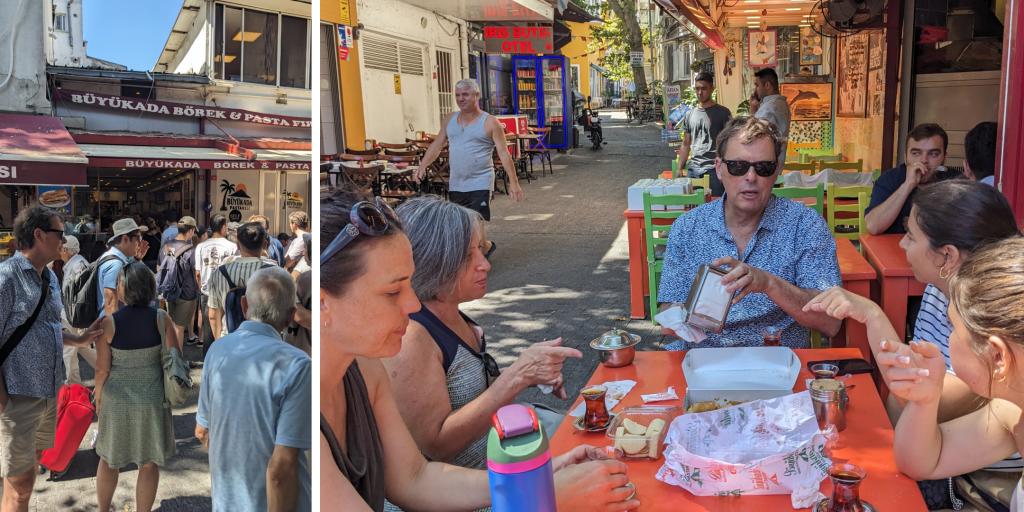
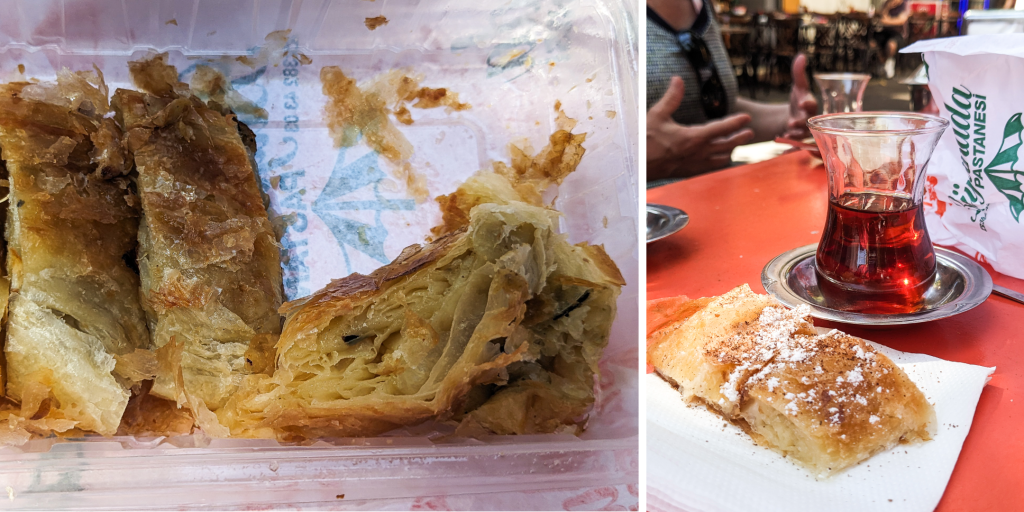
Lokumlu kurabiye (Turkish delight cookie), judiciously filled with a delightfully easy-to-chew mastic-flavored Turkish delight, was the other highlight of our morning treat—a perfect accompaniment to the varyingly bitter and warmly welcoming Turkish tea we kept having in most places we visited. Lian told us that the bakery owner, Huseyin Karayaprak, had taken over the business from its original Greek owner, Niko Mundi, with whom he apprenticed since he was a teenager. Even though we’d have been happy to continue sipping our tea, nibbling and chatting, we blended back into the crowd following Lian. As we got up, Amy quietly told me we could possibly come back to this bakery to learn more.
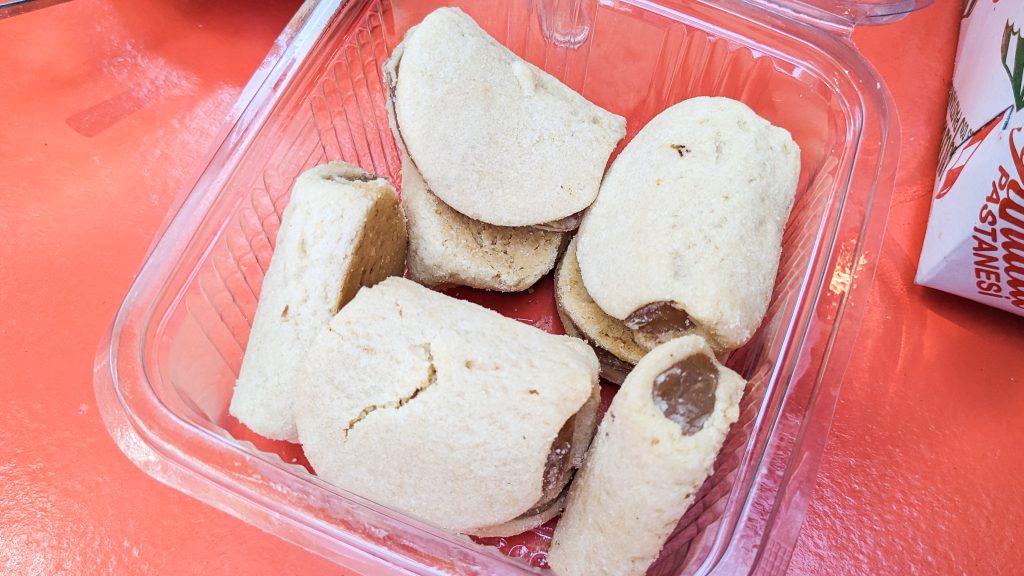
Working our way towards the house for the day’s workshop, Lian couldn’t help but share with us potato croquettes and kadinbudu kofte (kadinbudu, meaning “women’s thigh”) from her childhood corner market, where they have been fried and sold fresh, ready to satisfy the cravings of islanders and nowadays a lot of tourists, too. Kadinbudu kofte is a type of meatball with rice, dipped in an egg batter before deep frying—fast-ish food nostalgia. We happily tried and continued to entertain our taste buds. Next, up a slight hill, we arrived at the Splendid Palace Hotel, a beautiful, red-shuttered island institution that has been hosting guests since the early 20th century.
A quick excursion in and out of the hotel lobby confirmed its nostalgic yet renewed grandeur, but we settled at the Choco White cafe at its ground level, already feeling ready to escape the heat in some shade. This felt like a more modern patisserie compared to the ones we have been visiting. The owner explained to us how they had their own twist or adaptation on the classics they chose to make. For example, as dedicated as they were to the craft, they didn’t want to just replicate the profiteroles that are so common in Istanbul. They instead created what they called an inside-out profiterole pudding. We ended up sharing a slice of their “Budapest Cake”, an almond-hazelnut based gluten-free crust rolled around a filling of white-chocolate cream and their choice of seasonal fruit—it was peach this time. I didn’t say it then, but I could have easily had a second slice just for myself. It was light, flavorful and so refreshing for a summer day. The name, I learned talking to the owner, was not representative of the origin of the cake. It was their adaptation of a desert that is popular in Sweden, adjusted to “suit the tastes of our people”. Well, it delighted our taste buds, too, and Amy was already thinking how it could be a great fit for our bakery in Ann Arbor.
Our trek afterwards took us away from the crowds, onto the quieter neighborhood streets, and before long, we arrived at the apartment building where we were going to have our second workshop. Our host, Olcay, and our teacher, Luna, greeted us with the liveliness and warmth I have come to expect from my visits in Turkey and Cyprus. Olcay and Luna didn’t speak much English, so I happily volunteered to translate, with some help from Lian as well. Our workspace was the balcony of the house, large enough for a table to be our bench, plus some seating space for us all. Natural light, the breeze, and the views on top of all the learning and connection that awaited us… we couldn’t have asked for more!
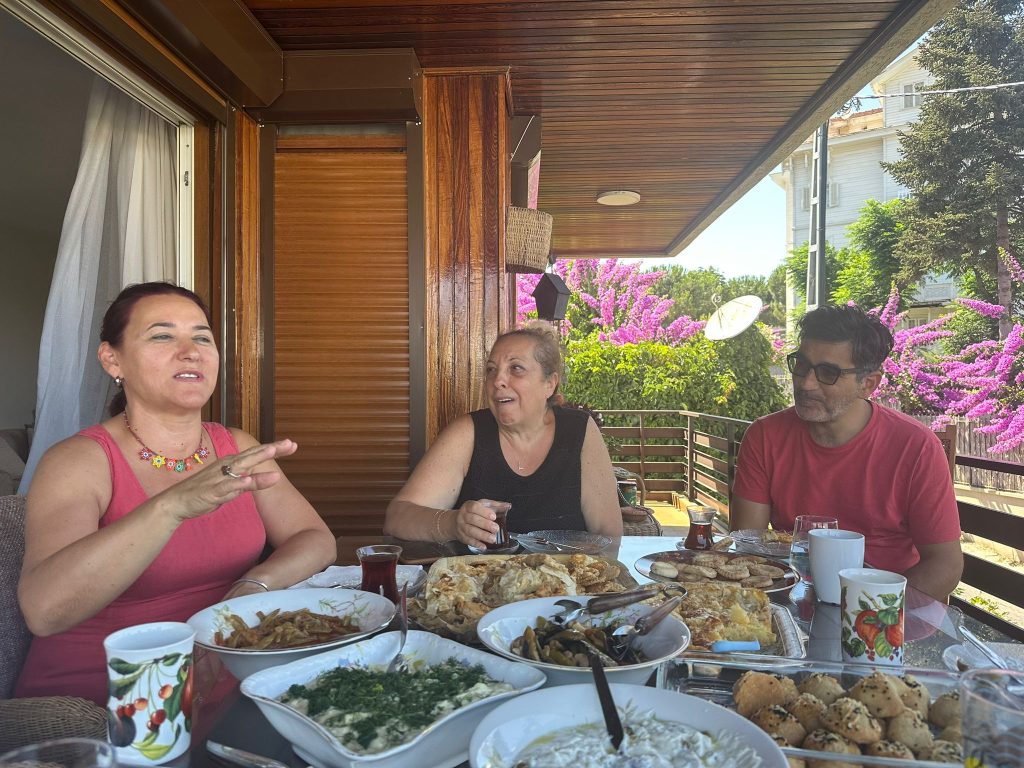
As we learned from Lian during the planning stages for this trip, the Sephardic-Jewish culinary scene in Istanbul and other parts of Turkey, was much more alive in home kitchens than in bakeries or restaurants. Maybe a few individuals, we were told, transformed their passion into a semi-professional catering business to provide traditional Sephardic-Jewish foods for life events or religious celebrations in this small community, such as bar-mitzvahs or funerals. Luna was in this category, cooking and baking out of her home. She told us how she taught herself a lot of the traditional Sephardic recipes by reading and making them out of cookbooks. We were definitely lucky to be in the company of such a guardian of the Sephardic-Jewish culinary heritage. Not only that, she was the only Sephardic-Jewish person we met who was still regularly speaking Ladino in her home, the medieval Spanish-derived language of this dwindling culture. We could tell she loved preparing her food and calling out their names in Ladino with pride.
As she talked, she rolled up her sleeves and got to mixing the first dough, for borekas (or borekitas), the empanada-like small pocket of pastry that we tried at the Kurtulus Pastanesi on the first day of our tour. This version had a potato-cheese filling. Amy and I were on the other side of the table, listening, taking notes and photos. Luna prepared the ‘big dough’, demonstrated, and we, the students, then took a piece of the dough to work on our own versions, similar to what we do at BAKE!, our baking school. Luna’s swift movements with the making of the food and the way she described the ingredients and the process (e.g. “one tea glass of sugar”, “as much flour as it takes”, or “knead the dough to the consistency of your ear lobe”), reminded me of my mother in the kitchen. I loved it. Here I was, back in Istanbul, engaging with amazing food again; hearing, talking, and connecting in Turkish (and English this time), but also learning something so new—a culture that was part of the vast fabric of this city, of this country, that I was not so aware of growing up.
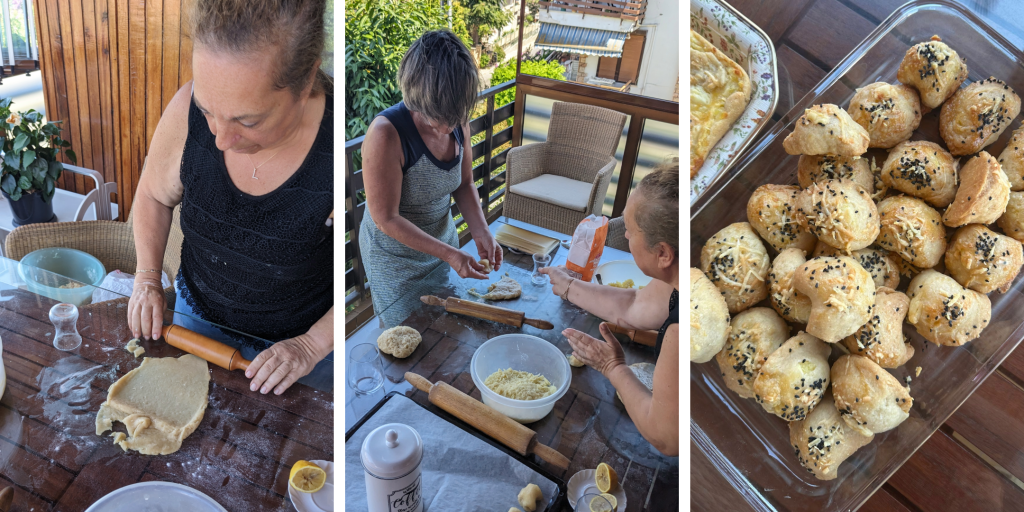
Besides the borekas, Luna showed us how to make black pepper cookies, aniseed cookies, and marzipan. She also had chester and Oznei Haman (or Orejas de Haman) on her list, but we ran out of time to make those. We were familiar with the triangular filled pastry, Oznei Haman, as we make the Ashkenazi version, Hamantaschen, for the Jewish holiday, Purim, in our bakery. Based on her description, chester sounded like an oil-based cheese scone with the original Sephardic name, boyikos. Knowing that we are bakers, Luna chose these items because they were some of the traditional staples she prepared for various events she catered to. Ring-shaped aniseseed cookies, for example, were the choice for funerals, in addition to black olives, boiled eggs, almonds, raisins, and white cheese.
Black pepper cookies were the only spiced food we made, with cloves and just enough black pepper to darken the dough and have a hint of black pepper at the back end with every bite. The sliver of sugar Amy and Luna carefully placed on top of the raw cookies, was a simple touch that added sweetness and a beautiful visual contrast. It was neat to discover the resemblance between these traditional cookies and the German pfeffernüsse holiday cookies we make in our bakery. For the marzipan, Luna quickly combined warm sugar syrup with almond meal and let it rest. Once cool enough, we all rolled them into balls which were then to be dipped in powdered sugar and let to dry out overnight. This was no-fuss baking, relatively simple yet flavorful with sparse use of spices, and vegetable or seed oil as the choice of fat. It wasn’t that dissimilar from the Mediterranean-influenced Turkish cooking I was familiar with.
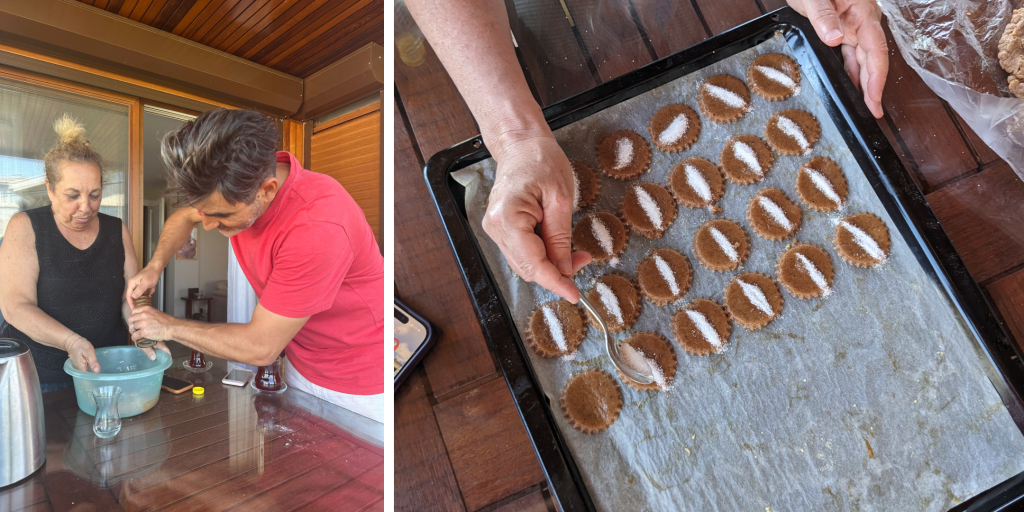
As we made all this food together, Luna lovingly answered our questions, shared her own story and talked about the Sephardic-Jewish culture in Istanbul. Lian and Olcay were generous helpers, fetching ingredients from the kitchen as needed (Lian even asked the upstairs neighbor for some sugar!), cleaning up and also sharing their own tips and stories. Luna was impressed with Amy’s skills and declared that she would have her in her kitchen in a heartbeat!
Our workshop felt mutually satisfying for us all there, and just as we thought it couldn’t get any better, our host, Olcay, treated us to her own cooking for lunch in addition to all the baked goodies. Her zeytinyagli fasulye (romano beans with olive oil, tomatoes and onions), balik biber salatasi (garlicky yogurt with pickled charred hot peppers), and patlican salatasi (fire roasted eggplant with garlicky yogurt), all served cold, were just perfect in the summer heat of the islands. It reminded me of my childhood, how my mom would show her hospitality with the delicious foods she would prepare and humbly share with our guests. We ended our day with hugs and exchanges of invites to Ann Arbor and Istanbul. As we walked away, we could see Olcay waving at us from the second-story balcony where we felt the warm welcome and generous sharing spirit of our new Sephardic and Turkish friends.
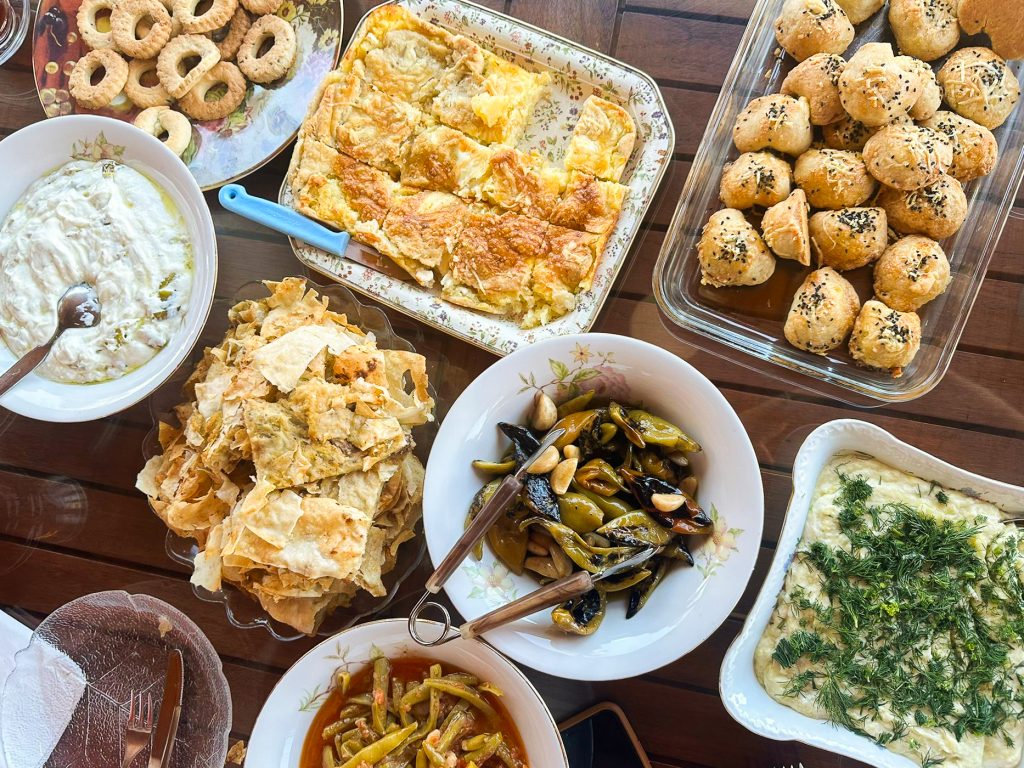
We hurried up to catch the ferry back to Burgazada for a quick rest, followed by a festive dinner with Lian, Simone, and their family at a local, hill-top restaurant known for its food and especially its view of the sunset. Our research trip was already meeting our expectations and maybe more. As I laid in bed so ready for a good night’s sleep, it was hard for me not to feel overwhelmed, in a good way, by our experience and anticipation of the days ahead in Istanbul and then Izmir.
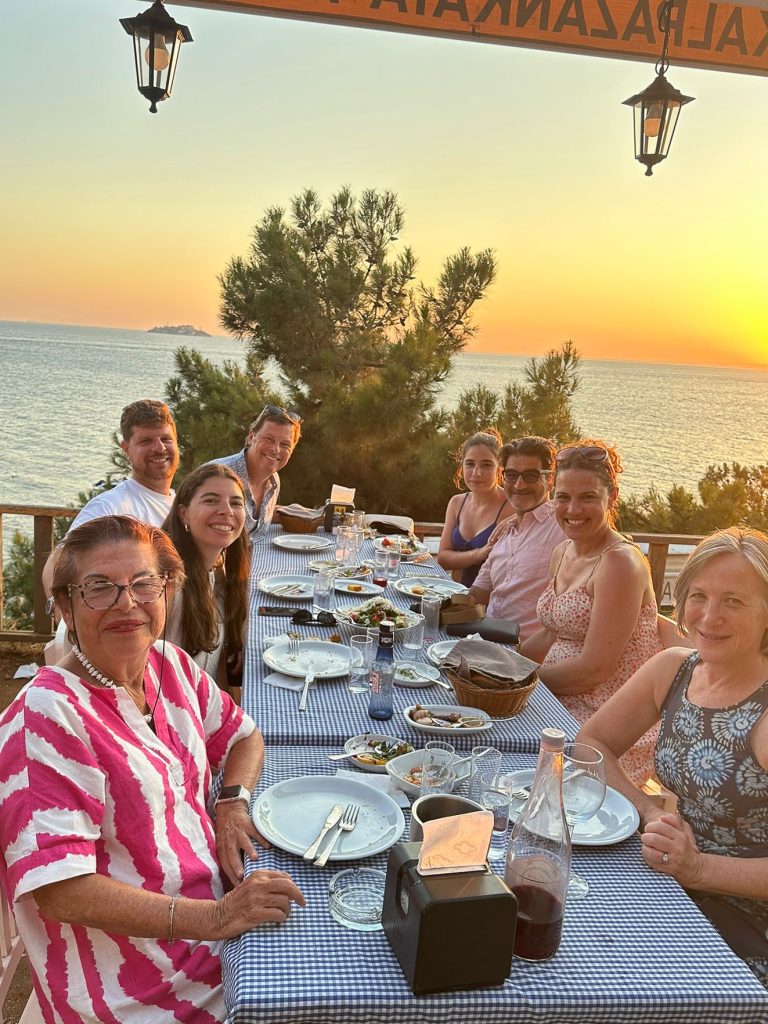
Originally from the island of Cyprus, Hazim decided to immerse himself in the world of bread baking and all foods fully flavorful after a career in environmental engineering. He joined the Bakehouse team in 2016 with a focus on bread quality and innovation. You may find him at the bench with his baker friends rolling Farm dough, milling flours on our stone mills, teaching a Naturally Leavened Bread class at BAKE!, tasting breads, loudly (he calls it "passionately") elaborating on the benefits of whole-grain flours or temperature for sourdough baking, or stopping in his tracks to think about the next possible bread or improvement. Science is dear to him, and he loves windsurfing!! He was recently featured on Rise Up! The Baker Podcast with Mark Dyck talking about getting his start in baking, the tension of leaping into a new career, and working on a team where he can be his whole self.
